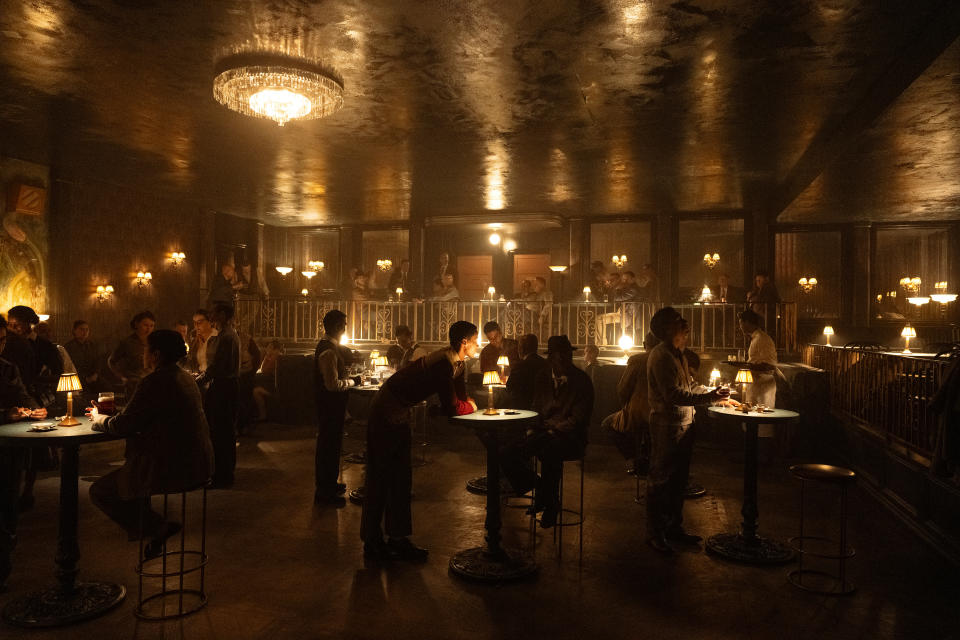‘Fellow Travelers’ Recreates a Real-Life ’50s Gay Bar — With a Little Added Cinematic Flair

If films and series about queer Americans in the 20th century can sometimes feel like a march through collective trauma, well, much of the 20th century was traumatic for the LGBTQ community. And Showtime’s new limited series “Fellow Travelers” (adapted from Thomas Mallon’s novel by Ron Nyswaner) includes a lot of it, from the lavender panic of the McCarthy era through the White Night riots in the aftermath of Harvey Milk’s assassination to the AIDS crisis of the 1980s. But woven throughout those momentous events, along with the star-crossed romance between Hawkins Fuller (Matt Bomer) and Tim Laughlin (Jonathan Bailey), are historically accurate moments of queer joy. Yes, gay culture existed (and thrived!) pre-Stonewall.
“I was the only person employed longer on the show than our researcher, Louis Gropman,” Nyswaner told IndieWire. That attention to detail shows throughout, from the opening credits (a montage of real photos of queer love) to the haven for the D.C. queer community, The Cozy Corner.
More from IndieWire
“The Cozy Corner was a historical, predominantly Black bar near Howard University,” Nyswaner said. “And there were a handful of white patrons. We use that in the series to sort of illustrate the hypocrisy of desegregated Washington, D.C.”

Within the context of “Fellow Travelers,” The Cozy Corner provides a glimpse of what gay life can be to the deeply closeted Tim, still wrestling to reconcile his sexuality with his faith. Black journalist Marcus brings him there as an antidote to the more transactional gay world through which Hawkins moves; The Cozy Corner provides a sense of community, along with a love interest for Marcus in drag queen Frankie (Noah J. Ricketts). Within its walls, men dance and drink together, and drag queens and kings perform — including real-life drag star Stormé DeLarverie (Chelsea Russell). “Thematically, these men are so desperately in need of a place to feel ensconced and safe,” Nyswaner said. But that need and the reality didn’t match up.
“I found a description of [the real] The Cozy Corner,” production designer Anastasia Masaro told IndieWire. “And it was described as this: ‘It looked like it was about to burn down. And then it finally did.’ This was not a cinematic club that worked with the aesthetic of this beautiful show with these beautiful people.”
Instead, Masaro created the multi-level version of The Cozy Corner that left Nyswaner in tears the first time he walked through — despite its size, which resulted in the need for more extras. “She saw it as a vaudeville theater that had become a speakeasy that was now a gay bar, and that’s her genius,” Nyswaner said.

Masaro, meanwhile, points out that the club was larger than initially expected because “this is going to be in multiple episodes. There’s people coming in and out of different entrances. All these little spots with different conversations, and it’s gonna be really boring if I just make you a little box. It wasn’t that big — the ceilings were high and I did multiple levels thinking, ‘Camera views. I’ve got to present options.’ Plus, I did mirror all the way around because these days I’ve got to give the DP enough practicals to light the sets.”
Among the lighting solutions were sconces with carefully singed shades as an homage to the description of the original Cozy Corner that Masaro came across. “And then somebody kept running around turning them around trying to be helpful,” she said with a laugh.
More fruitful was Masaro’s collaboration with costume designer Joseph La Corte. “Joseph and I were always talking. We were constantly talking,” she said.
“I’m holding up fabric. She’s holding up paint swatches,” La Corte told IndieWire. “‘Well, you know, this could work together in this room. If I put her in this red dress, is the piano gonna be black? I wanna make sure the piano is shiny so that the reflection of this red sparkle shows.’ There’s tons of that conversation that happens.”
Masaro didn’t have photos of the real Cozy Corner interior with which to work (not that they would have been helpful for this version), but La Corte was able to reference the real Stormé DeLarverie and her backup performers for the drag shows that pepper early episodes of “Fellow Travelers.”

When creating Frankie, however, La Corte had to thread the needle between glamour and reality, finding a cozy middle that would allow Frankie to look great while still showing that drag was not big business back then.
“For Frankie, we took inspiration from people like Billie Holiday, Eartha Kitt, Diana Washington,” La Corte said. “That helped influence his style and [Ricketts’] idea of how to play the character as well.” But Frankie was still a drag queen emulating goddesses on a budget. “Frankie lives above The Cozy Corner in a little room, and he either goes to the thrift shop or he makes his clothes,” La Corte said. “There were so many lives lived before us, and we want people to see what life was really like.”
“I think that was what was extremely special for me on this show: Everyone had such a passion to get this right,” La Corte added. “We just wanted to get it right because you get one crack at opening this pearl to the world.”
“Fellow Travelers” releases new episodes on Paramount+ and Showtime every Sunday through the finale on December 17.
Best of IndieWire
Sign up for Indiewire's Newsletter. For the latest news, follow us on Facebook, Twitter, and Instagram.


